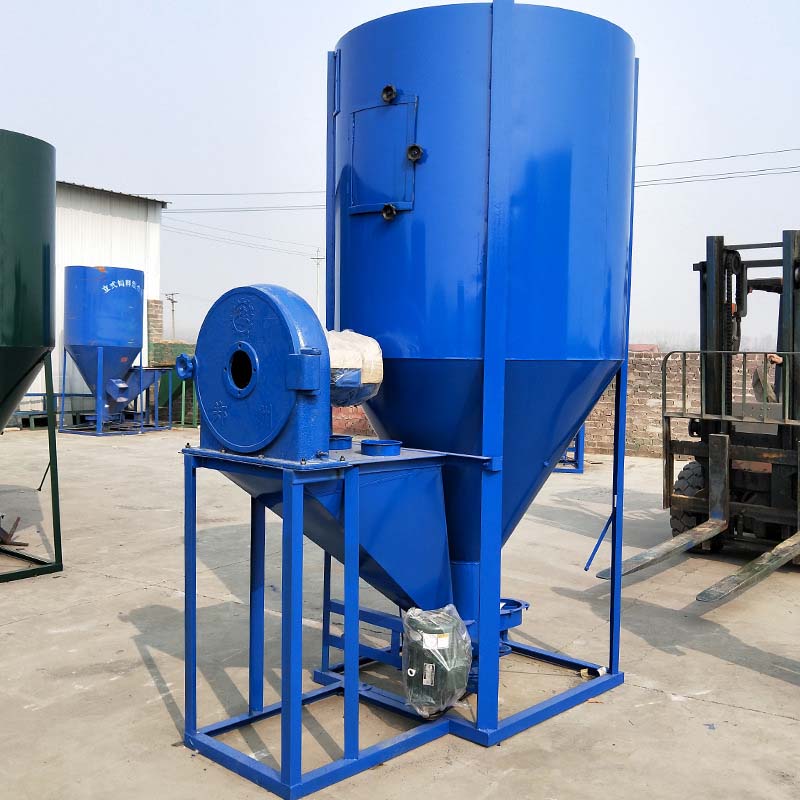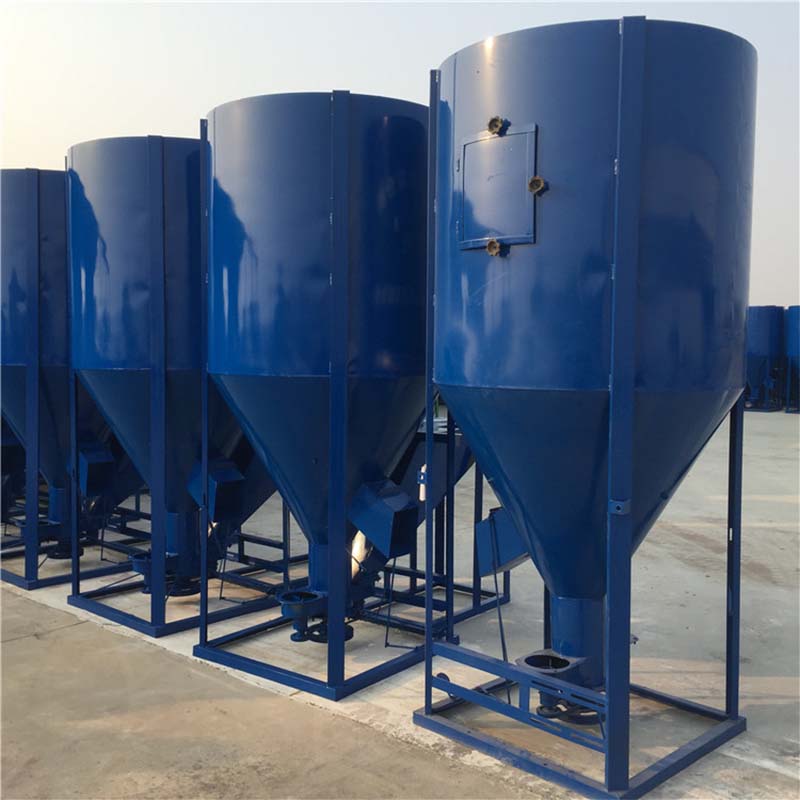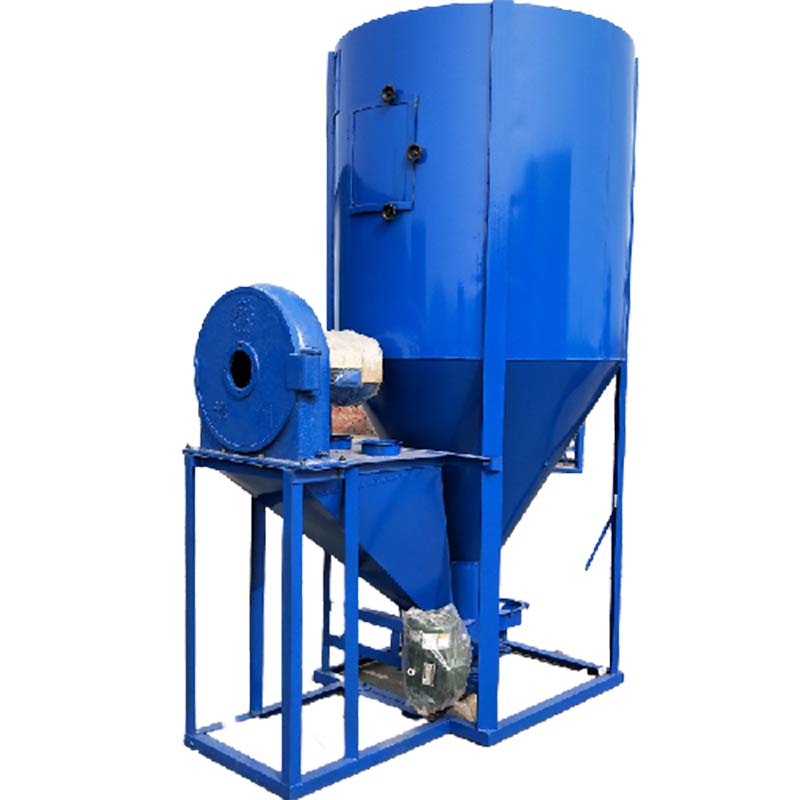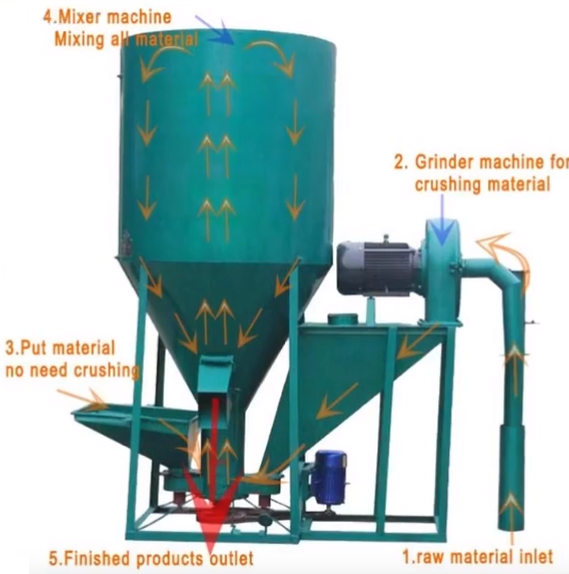High-Efficiency Feed Miller with Mixer | Quality Animal Feed Production
Aug . 29, 2025 02:00 Back to list
High-Efficiency Feed Miller with Mixer | Quality Animal Feed Production
Driving Efficiency: The Evolution of Feed Processing Technology
In the rapidly evolving landscape of animal agriculture, optimizing feed production is paramount for profitability and sustainability. Modern livestock operations, from poultry and swine to aquaculture and cattle, demand precise, uniform, and cost-effective feed formulations. This necessity has driven significant innovation in feed processing machinery, particularly the integrated solutions that combine grinding and mixing. The feed miller with mixer stands as a cornerstone in this technological advancement, offering a streamlined approach to feed preparation.
The global animal feed market is projected to reach over USD 500 billion by 2030, with a Compound Annual Growth Rate (CAGR) of approximately 4.5% (source: Grand View Research, 2023). This growth is fueled by increasing meat and dairy consumption, alongside a rising focus on animal health and productivity. Integrated solutions like the vertical feed mixer with grinder are crucial for meeting this demand by enhancing operational efficiency, reducing labor costs, and ensuring consistent feed quality. The shift towards higher automation and energy-efficient designs is a dominant trend, directly influencing the design and adoption of advanced feed processing units.
This document delves into the technical intricacies, application benefits, and strategic considerations for deploying state-of-the-art feed milling and mixing equipment, with a specific focus on the combined functionality of a feed miller with mixer.
Integrated Process Flow: From Raw Material to Homogenized Feed
The manufacturing process utilizing a vertical animal feed mixer with grinder integrates several critical steps to transform raw ingredients into a uniformly mixed feed. This integrated system optimizes material handling and processing, minimizing manual intervention and reducing contamination risks.
Key Stages of Operation:
- Ingredient Loading: Raw materials such as grains (corn, barley, wheat), protein sources (soybean meal, fish meal), and supplements (vitamins, minerals) are loaded into the intake hopper. Modern systems often feature automated conveying mechanisms to ensure continuous supply.
- Milling/Grinding: The raw materials are gravity-fed or auger-fed into the hammer mill section. Here, high-speed rotating hammers impact and shear the ingredients against a screen, reducing them to a desired particle size. The fineness of grinding is critical for digestibility and optimal mixing. Typical screen sizes range from 2mm to 10mm, depending on the animal species and feed type.
- Homogenization (Mixing): Post-grinding, the milled ingredients are conveyed into the vertical mixing chamber. A large-diameter central auger lifts the material from the bottom of the chamber to the top, allowing it to cascade downwards. This continuous upward movement and downward fall ensure a thorough, three-dimensional mixing action, achieving a Coefficient of Variation (CV) typically below 5% within 10-20 minutes, a benchmark for high-quality feed.
- Discharge: Once the mixing cycle is complete, the homogeneous feed batch is discharged from the bottom outlet, often via a slide gate or screw conveyor, directly into bagging systems, storage bins, or subsequent processing stages like pelletizing.
Product Materials and Manufacturing Excellence:
The durability and performance of a feed miller with mixer largely depend on the quality of its components. Critical parts are fabricated from high-grade materials:
- Mixing Chamber & Auger: Typically constructed from Q235B Carbon Steel for robustness, or 304 Stainless Steel (SS304) for applications requiring enhanced corrosion resistance and hygiene, especially when processing ingredients with high moisture content or specific additives.
- Hammer Mill Hammers: Manufactured from wear-resistant alloy steel, often through precision forging and heat treatment, to ensure extended service life and consistent grinding efficiency.
- Screens: High-carbon steel or stainless steel, laser-cut or perforated for precise particle sizing and resistance to abrasion.
- Motor & Bearings: Utilizing industrial-grade electric motors (e.g., Siemens, WEG) and sealed, self-aligning bearings (e.g., SKF, FAG) to ensure reliable operation, energy efficiency, and minimal maintenance.
Manufacturing processes involve advanced techniques such as CNC machining for high-precision components, automated welding for robust structural integrity, and multi-stage surface treatments for enhanced longevity. Each unit undergoes rigorous testing conforming to international standards like ISO 9001 for quality management and CE for European safety compliance. Operational service life typically exceeds 10-15 years with proper maintenance, showcasing the robust engineering.
Target Industries and Application Advantages:
While primarily serving the animal agriculture sector (poultry farms, swine operations, cattle ranches, aquaculture facilities), the principles of a feed mixer are also applicable in other industries requiring bulk material blending and size reduction, such as:
- Organic Fertilizer Production: Blending various organic components and grinding coarser materials.
- Biomass Processing: Preparing biomass for further energy conversion.
- Chemical Industry: Mixing powdered chemicals or additives, though material compatibility would be a key consideration.
In typical agricultural scenarios, the integrated unit demonstrates significant advantages, including up to 20% energy saving compared to separate grinding and mixing units, reduced dust emission due to enclosed design, and superior homogeneity leading to improved feed conversion ratios (FCR) in livestock. The robust construction provides excellent corrosion resistance, particularly for stainless steel variants, ensuring longevity even in challenging agricultural environments.

Technical Specifications: Precision Engineering for Optimal Performance
The performance characteristics of a high-quality vertical animal feed mixer with grinder are defined by a range of technical parameters that ensure efficiency, reliability, and precision. Understanding these specifications is critical for selecting the right equipment tailored to specific production capacities and feed types.
Product Specification Table: Vertical Animal Feed Mixer with Grinder
| Parameter | Unit | Model YZ-VMG500 | Model YZ-VMG1000 | Model YZ-VMG2000 |
|---|---|---|---|---|
| Rated Mixing Capacity | kg/batch | 500 | 1000 | 2000 |
| Mixing Time | min | 10-15 | 10-15 | 15-20 |
| Mixing Uniformity (CV) | % | ≤ 5 | ≤ 5 | ≤ 5 |
| Grinding Motor Power | kW | 7.5 | 11 | 18.5 |
| Mixing Motor Power | kW | 2.2 | 3 | 4 |
| Total Power Consumption | kW | 9.7 | 14 | 22.5 |
| Voltage/Frequency | V/Hz | 380/50 (Customizable) | 380/50 (Customizable) | 380/50 (Customizable) |
| Material of Construction (Contact Parts) | Carbon Steel (SS304 Optional) | Carbon Steel (SS304 Optional) | Carbon Steel (SS304 Optional) | |
| Machine Weight | kg | ~350 | ~550 | ~800 |
| Dimensions (L×W×H) | mm | 1100×1100×2800 | 1300×1300×3200 | 1500×1500×3800 |
These parameters highlight the robust design and engineering precision embedded in each animal feed mixer. The 'Coefficient of Variation (CV)' is a critical metric for mixing performance, with values below 5% indicating excellent homogeneity crucial for uniform nutrient distribution and animal health.
The modular design allows for customization in motor power and material of construction, catering to diverse operational needs and environmental conditions.

Application Scenarios and Operational Versatility
The versatility of a combined grinding and mixing unit, often referred to as a vertical feed mixers with grinder, makes it indispensable across various animal production settings. Its ability to process a wide range of raw materials into tailored feed formulations ensures optimal nutrition for different animal types and life stages.
- Small to Medium-Sized Livestock Farms: Ideal for independent farms seeking to control feed quality and cost. These units enable on-demand production of specific feeds for cattle, pigs, and poultry, reducing reliance on commercial feed suppliers and allowing for quick adaptation to dietary changes.
- Aquafeed Production: For fish and shrimp farms, precise particle size and uniform ingredient distribution are critical for water stability and nutrient absorption. Stainless steel models are often preferred here due to the corrosive nature of some aquatic feed ingredients and the need for stringent hygiene.
- Pet Food Manufacturing: Crafting specialized diets for pets requires meticulous blending of ingredients. The precision grinding and mixing capabilities ensure that each kibble contains the exact nutritional profile.
- Research and Development Facilities: Universities and agricultural research centers utilize these mixers for experimental feed formulations, requiring high accuracy and repeatability in small batch productions.
- Feed Mills (Supplemental Production): Larger feed mills may use these smaller, integrated units for producing specialized, high-value, or medication-laden feed batches that require strict segregation from main production lines.
In each scenario, the objective is consistent: to produce homogeneous feed that maximizes animal health and growth performance while minimizing waste and operational costs. The integrated design reduces footprint and simplifies operation, making it a cost-effective solution for diverse agricultural enterprises.

Technical Advantages and Performance Differentiation
The inherent design and engineering of advanced vertical feed mixers for sale offer distinct technical advantages that set them apart from conventional, separate grinding and mixing systems. These advantages translate directly into operational efficiencies and economic benefits for the end-user.
- Integrated Design & Space Efficiency: By combining the milling and mixing functions into a single vertical unit, the machine significantly reduces the required operational footprint. This is a critical advantage for facilities with limited space, simplifying layout and reducing installation costs.
- Energy Efficiency: The direct-drive mechanism for both grinding and mixing, coupled with optimized material flow, results in lower energy consumption per ton of feed produced. This is a crucial factor in reducing operational expenses, especially with fluctuating energy prices. Data from industry reports suggests up to 15-20% energy savings compared to two-stage systems.
- Superior Mixing Homogeneity: The vertical auger design ensures a thorough, top-to-bottom material circulation, leading to a Coefficient of Variation (CV) typically below 5%. This level of homogeneity is essential for preventing nutrient segregation, ensuring animals receive a balanced diet in every bite, and optimizing feed conversion rates.
- Reduced Dust Emission & Noise: The enclosed nature of the vertical system significantly minimizes airborne dust particles during operation, contributing to a cleaner, safer working environment and reducing material loss. Additionally, modern designs incorporate noise dampening features, lowering operational sound levels.
- Simplified Operation & Maintenance: With fewer moving parts and a consolidated control system, these integrated units are easier to operate and maintain. Fewer transfer points also mean less wear and tear, contributing to extended service life and reduced downtime.
- Versatility in Material Processing: Capable of handling a diverse range of dry granular materials, from various grains and legumes to concentrated protein meals and micro-ingredients. The interchangeable screens allow for rapid adjustment of particle size to suit different animal feed requirements.
- Robust Construction & Durability: Built with heavy-gauge steel and precision-engineered components, ensuring long-term reliability even under continuous, demanding industrial use. Options for stainless steel construction further enhance resistance to corrosion and facilitate easier cleaning.
These combined benefits underscore the value proposition of investing in an advanced integrated animal feed mixer, delivering both performance and economic advantages to feed producers.

Vendor Comparison: Choosing the Right Feed Processing Partner
Selecting a supplier for a crucial piece of equipment like a feed miller with mixer requires careful consideration of not just product specifications, but also vendor reputation, service capabilities, and long-term support. While many manufacturers offer similar machinery, key differentiators emerge in quality, customization, and after-sales support.
Key Comparison Factors:
- Build Quality & Materials: Leading vendors differentiate themselves by using higher-grade steel (e.g., SS304 vs. SS201), superior welding techniques, and industrial-grade motors/components from reputable brands (e.g., Siemens, SKF). This directly impacts durability and operational lifespan.
- Mixing Performance & Homogeneity: While most claim low CVs, validated test data (e.g., ISO 17025 accredited lab reports) and independent third-party assessments can confirm actual performance under various load conditions. Superior auger design and mixing chamber geometry contribute significantly here.
- Energy Efficiency: Specific power consumption (kWh/ton) metrics are crucial. Vendors who invest in optimized motor selection, efficient transmission systems, and aerodynamic designs often achieve better energy performance.
- Customization Capabilities: The ability to tailor machine capacity, material contact parts (carbon steel vs. stainless steel), motor voltage/frequency, and integrate with existing feed lines is a significant advantage.
- Certifications & Compliance: Adherence to international standards such as ISO 9001, CE, and in some regions, specific food-grade machinery certifications (e.g., FDA compliance for certain contact materials), indicates a commitment to quality and safety.
- After-Sales Support & Warranty: Comprehensive warranties (e.g., 1-2 years on major components), readily available spare parts, and responsive technical support (remote and on-site) are vital for minimizing downtime.
Vendor Comparison Table (Illustrative):
| Feature | Yize Machine (Example) | Competitor A (Budget Option) | Competitor B (Premium Option) |
|---|---|---|---|
| Mixing Uniformity (CV) | ≤ 5% (Verified) | ≤ 7% (Claimed) | ≤ 3% (Verified) |
| Key Component Suppliers | Schneider/Siemens (Motors, Electrics) | Generic (Local Brands) | ABB/SKF (Motors, Bearings) |
| Material Options | Carbon Steel, SS304 | Mostly Carbon Steel | SS304, SS316 |
| Customization Level | Moderate to High | Limited | Extensive |
| Certifications | ISO 9001, CE | Basic CE | ISO, CE, cGMP |
| Warranty (Major Parts) | 18 Months | 12 Months | 24 Months |
| Technical Support | Remote & On-site Available | Email/Phone Only | 24/7 Global Support |
Yize Machine, with its commitment to quality components and verified performance, positions itself as a strong contender offering a balance of performance, durability, and cost-effectiveness for the modern feed producer. This strategic positioning ensures a reliable investment without the premium price tag of ultra-specialized systems.

Customized Solutions and Client-Centric Engineering
Recognizing that every operation has unique requirements, Yize Machine specializes in providing customized solutions for the feed miller with mixer, ensuring that the equipment seamlessly integrates into existing production lines and meets specific operational demands. Our engineering team collaborates closely with clients to understand their exact needs, from capacity requirements to material specifications and environmental constraints.
Areas of Customization:
- Capacity Scaling: Adapting batch sizes from smaller R&D units (e.g., 200kg) to large-scale commercial operations (e.g., 5000kg) by adjusting chamber volume and motor power.
- Material of Construction: Offering options from standard carbon steel for general-purpose feed to full SS304 or SS316 stainless steel for enhanced hygiene, corrosion resistance, and suitability for specific food or pharmaceutical-grade applications.
- Motor & Electrical System: Customizing voltage, frequency (e.g., 220V/60Hz, 415V/50Hz), and control systems (e.g., PLC integration, variable frequency drives for speed control) to match local electrical grids and automation requirements.
- Feeding & Discharging Mechanisms: Integrating with various upstream (e.g., automated auger feeders, belt conveyors) and downstream systems (e.g., pneumatic conveying, bagging lines, pellet mills) to create a fully automated solution.
- Dust Collection & Safety Features: Incorporating advanced dust collection systems, explosion-proof motors (for hazardous materials), safety interlocks, and emergency stops to meet specific industrial safety standards (e.g., ATEX directives for certain environments).
- Specialized Grinding Screens: Providing a range of hammer mill screens with varying hole sizes and configurations to achieve precise particle fineness for different animal ages and feed textures.
Our client-centric approach ensures that each unit is not just a piece of equipment but a tailored solution designed for maximum efficiency and return on investment. With over 20 years of experience in agricultural machinery, Yize Machine has built a reputation for delivering robust and reliable systems globally.

Application Case Studies: Proven Performance in Diverse Environments
The effectiveness of the vertical animal feed mixer with grinder is best demonstrated through real-world applications where it has delivered tangible benefits to our clients. These case studies highlight the versatility, reliability, and economic impact of our equipment.
Case Study 1: Large-Scale Poultry Farm in Southeast Asia
- Client Profile: A major integrated poultry producer with a capacity of 1 million birds, previously relying on outsourced feed.
- Challenge: High feed costs, inconsistent quality from external suppliers, and a desire to produce specialized starter and finisher feeds in-house.
- Solution: Installation of two Yize Machine YZ-VMG2000 vertical feed mixers with grinder units, customized for specific local grain types and equipped with automated dosing for micronutrients.
- Results:
- Cost Reduction: Achieved a 15% reduction in feed costs within the first year by eliminating supplier margins and optimizing raw material procurement.
- Improved FCR: Consistent feed quality led to a 3% improvement in Feed Conversion Ratio (FCR), significantly impacting profitability.
- Operational Efficiency: Reduced daily feed preparation time by 30% and required only two operators per shift, leading to labor savings.
Case Study 2: Boutique Organic Pig Farm in Europe
- Client Profile: A specialized organic pig farm known for premium meat products, focusing on locally sourced, non-GMO ingredients.
- Challenge: Need for a versatile system to process small batches of diverse, high-value organic ingredients with strict adherence to purity and avoiding cross-contamination.
- Solution: Implemented a Yize Machine YZ-VMG500 animal feed mixer with grinder, fabricated entirely from SS304 stainless steel, featuring easily changeable screens and a quick-clean design.
- Results:
- Quality Assurance: Ensured precise formulation control for various pig stages (weaner, grower, finisher), maintaining the farm's organic certification.
- Flexibility: The system allowed for rapid switching between different feed recipes, handling ingredients like organic peas, barley, and specialized forage.
- Reduced Waste: On-demand production minimized feed spoilage, crucial for high-cost organic ingredients.
These cases exemplify how Yize Machine's solutions contribute to operational excellence and bottom-line improvements across a spectrum of agricultural operations, cementing our position as an authoritative provider in the feed processing industry.

Trustworthiness and Support: Our Commitment to Clients
At Yize Machine, establishing enduring trust with our B2B partners is foundational. Our commitment extends beyond delivering high-quality equipment; it encompasses transparent processes, robust support, and unwavering dedication to client success.
Frequently Asked Questions (FAQs):
A1: Standard models typically have a lead time of 15-25 business days from order confirmation and deposit. Customized solutions may require 30-45 business days, depending on the complexity of specifications. We provide a detailed production schedule upon order placement.
A2: We offer an 18-month warranty on major mechanical components and a 12-month warranty on electrical parts from the date of shipment. This warranty covers manufacturing defects under normal operating conditions. Extended warranty options are available upon request.
A3: Our dedicated after-sales team provides comprehensive support, including remote troubleshooting via phone/video calls, and on-site technical assistance if required. We maintain a robust inventory of critical spare parts for immediate dispatch, minimizing potential downtime. A detailed spare parts manual is provided with each machine.
A4: Yes, our equipment is designed for flexible integration. We can customize input hoppers, discharge heights, and control interfaces to seamlessly connect with existing conveying systems, PLCs, and supervisory control systems. Our engineers can provide detailed integration diagrams and support.
Lead Time & Fulfillment:
Yize Machine prides itself on efficient order fulfillment. Our lead times are meticulously managed to balance custom fabrication needs with timely delivery. We work with trusted logistics partners to ensure secure and prompt global shipping, providing clients with tracking information and regular updates throughout the transit process. Pre-shipment inspections and performance tests are standard procedures to guarantee product quality upon arrival.
Warranty Commitments:
Our comprehensive warranty reflects our confidence in the engineering and durability of our equipment. All Yize Machine products adhere to stringent quality control, holding ISO 9001 certification. We stand by the reliability of our components and workmanship, offering clear, actionable warranty terms that protect your investment.
Customer Support and Partnership:
Our commitment to customer satisfaction extends throughout the entire lifecycle of our products. From initial consultation and system design to installation support, operator training, and ongoing technical assistance, Yize Machine acts as a true partner. Our global network of service professionals ensures that expert help is always within reach, minimizing operational disruptions and maximizing machine uptime. We believe that robust after-sales support is as critical as the quality of the machinery itself, fostering long-term relationships built on mutual success.
Conclusion
The integrated vertical animal feed mixer with grinder represents a significant advancement in feed processing technology, offering unparalleled efficiency, precision, and operational reliability. Its ability to simultaneously mill and mix raw materials into homogeneous feed formulations provides substantial economic benefits through reduced labor, lower energy consumption, and improved animal health outcomes. As the global demand for high-quality, cost-effective animal feed continues to grow, investing in a technologically advanced feed miller with mixer from a trusted partner like Yize Machine is a strategic decision for any forward-thinking agricultural enterprise. Our commitment to engineering excellence, customized solutions, and comprehensive after-sales support ensures that clients receive not just equipment, but a complete solution designed for long-term success.
References
- Grand View Research. (2023). Animal Feed Market Size, Share & Trends Analysis Report By Animal Type (Poultry, Swine, Ruminant, Aquaculture), By Form (Pellets, Crumbles, Mash), By Region, And Segment Forecasts, 2023 - 2030. Retrieved from www.grandviewresearch.com.
- American Feed Industry Association (AFIA). (2022). Feed Industry Fact Sheet. Retrieved from www.afia.org.
- FAO. (2021). The Future of Food and Agriculture – Drivers and Triggers for Transformation. Rome. Retrieved from www.fao.org.
- Journal of Agricultural Engineering and Technology. (2020). Optimizing Feed Mixer Performance for Livestock Production. Vol. 23, No. 2, pp. 112-125.
- ISO 9001:2015. (2015). Quality management systems – Requirements. International Organization for Standardization.
-
Evisceration Table - Hygienic, Stainless Steel, Easy-Clean
NewsNov.17,2025
-
Chicken Plucker and Scalder | Fast, Stainless, Adjustable
NewsNov.17,2025
-
Silo Solutions: Durable, Automated, Batching-Ready Storage
NewsNov.17,2025
-
Automatic Drinking Line for Poultry | Precise & Durable
NewsNov.17,2025
-
Cutting Machine for Meat & Bone | High-Precision, Safe
NewsNov.17,2025
-
Chicken Feet Peeling Machine | Fast, Hygienic, High-Yield
NewsNov.10,2025






